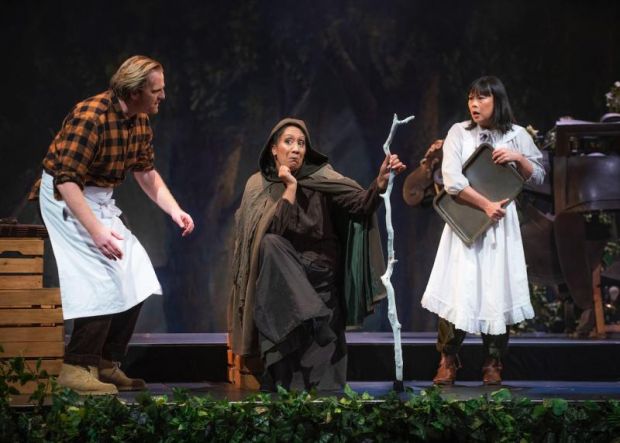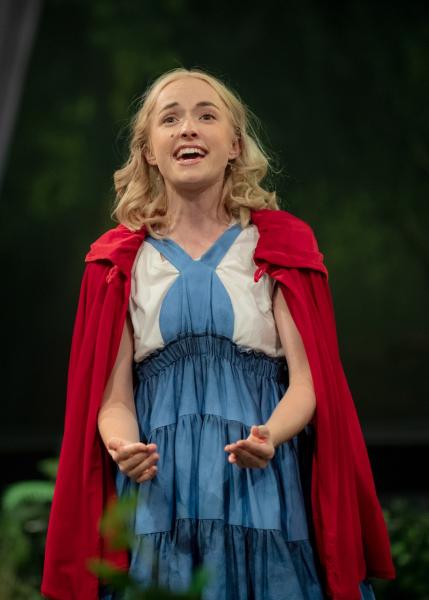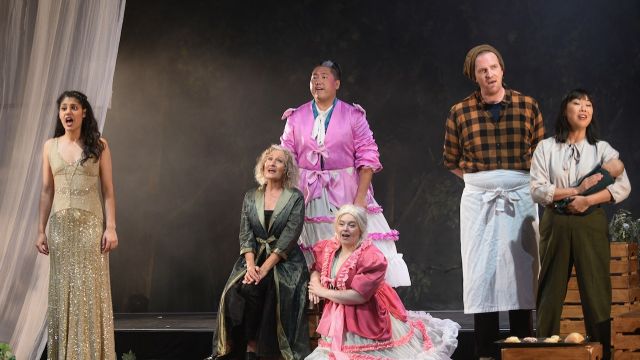Into the Woods
‘Once upon a time…’ Into the Woods reworks and combines and subverts old and familiar ‘fairy tales: Cinderella, Jack and the Beanstalk, Little Red Riding Hood and – a central thread – a Baker and his Wife who long for a child. It has all the hallmarks of Sondheim and Lapine’s work: the distinctive music, the clever, pointed lyrics with their internal rhymes, puns and character revelation, the instant switches in the storytelling from pathos to comedy, from bubbling joy to the deepest sadness, and a confronting moral ambiguity. ‘Be careful what you wish for.’
If you have never seen a production of Into the Woods, a plot summary has so many characters and so many storylines, that the whole enterprise may seem overloaded and impossibly complex. But it is the most popular and most performed of Sondheim and Lapine’s shows. Here, in this iteration, we have a very talented, professional cast, every one of whom is a skilled actor, singer, and a comedian. It’s a cast in the hands of two inventive directors – Sonya Suares and Melanie Hillman.

What these directors and their creative team have wrought in this cavernous Pavilion space is hugely impressive. The directors move their cast of twelve – playing twenty characters – across, through and around a space that can be deep in the woods, Cinderella’s kitchen, the Bakery, Jack’s house, Grandma’s house, or the Royal Palace – with the audience on three sides. Storylines intersect cleanly – with ironic consequences – transitions between scenes are smooth, and the pace never lets up.
Each of the characters’ desires means venturing into the woods – the dark and dangerous woods where anything can happen. But who could argue with the need for a child, a journey to sell a cow when the cupboard is bare, a girlish desire to go to the ball, or a visit to Grandma?

Even with seven of the cast playing double roles, we are never confused – helped along by co-director Melanie Hillman’s narration. Cinderella (Ava Madon) is sweet and touching, much put upon by her nasty Stepmother (Jackie Rees) and her equally nasty Stepsisters (Raphael Wong and Caitlin Spears), and not defended by her feeble father (John O’May). But, despite her ability to summon up birds to help her, Cinderella is worryingly naïve: is a ball at the palace all it’s cracked up to be?

Jack (Anthony Craig) loves his cow, Milky White, but she gives no milk, and his realistic Mother (Jacqui Hoy) insists the cow be sold. Craig makes his Jack a stubborn boy dominated by his mother, and when he disobeys instructions, with terrible results, he’s disturbing. Little Red Riding Hood (Lily Baulderstone) skips onto the stage – a delightful and funny insouciant with a sweet tooth – just the kind of girl to ‘stray from the path’ in the woods and, of course, meet the Wolf (Nick Simpson-Deeks). The honest Baker (James Millar) is stolid and fearful; he’ll need to be fired up (or corrupted?) by his Wife (Fiona Choi). Again, two nuanced performances: he the plodder who becomes brave and pragmatic; she charming but devious. Their childlessness is suddenly explained when they discover that they are cursed by the Witch (Cherine Peck), who lives next door… And that the curse can only be lifted by the impossible collection of four objects by midnight next day…

Later, there is not just one handsome (if shallow popinjay) Prince (Nick Simpson-Deeks doubling as specified), but also his brother (Raphael Wong again) who falls for Rapunzel (Caitlin Spears again), trapped in her tower by her mother, the Witch… The Witch is indeed a central controlling force, not entirely driven by malice: she too is prone to human mistakes – and in the hands of Cherine Peck, she is a bombshell.
This multi-strand but interlocking, coherent storytelling could not succeed without Sarah Tulloch’s economic but suggestive set design, Rob Sowinski’s bright-to-eerie lighting, Jodi Hope’s appropriately fairy tale costumes, and Marcello Lo Ricco and Steve Cooke’s enveloping sound design – especially menacing in Act II. And in this vast space, all the cast are miked, so Jake Sipic’s sound operation is a marvel.

Musical Director Ned Wright-Smith and Music Supervisor Trevor Jones, anchoring things at the piano, execute a score with abrupt changes of mood and style with clarity and sparkle, making their seven musicians sound like much more.
After the gloriously upbeat finale of Act I, ‘Ever After’, Act II plunges into darkness, depicting all the consequences of the bad decisions, thoughtless greed, shattered illusions, lies and trickery implicit in Act I. And we went along with it all. We wanted these characters to succeed thanks not just to the text, but also to the way the characters are created for us so well on stage. [Happily] Ever After? No such thing. Now an implacable force menaces the community, and the only comfort is the penultimate song, ‘No One Is Alone’ – and finally the rueful advice to parents of ‘Children Will Listen’.

This spirited production by the Watch This repertory company finally hits the stage after cancellation after cancellation – but only for five performances. ‘Worth the wait’ hardly seems the appropriate response, but this a fully satisfying night at the live – very live - theatre.
Michael Brindley
Photographer: Jodie Hutchinson
Subscribe to our E-Newsletter, buy our latest print edition or find a Performing Arts book at Book Nook.

